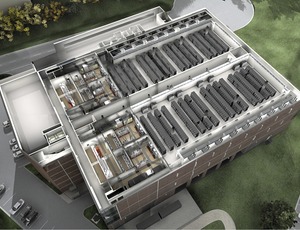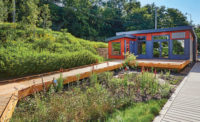

Data centers in the U.S. gulp an estimated 388 billion liters of potable water every year. Experts say that's enough water to fill 155 million Olympic pools or 820 billion grande drinks at Starbucks.
Like a laptop computer, rows of data center servers and other information technology (IT) equipment need to stay cool to work well. Unlike fan-cooled laptops, data centers—dense with servers stacked into rows and rows of racks—are mostly cooled using chilled-water systems. Those systems rely on large volumes of water that typically get discharged into the environment.
To date, data-center water consumption has not been a target for environmental activists. "We expect that to change quickly," says Jakob Carnemark, senior vice president for mission critical facilities in the New York City office of Skanska USA, which based the 388-billion-liter figure on data from the nonprofit building infrastructure group, ASHRAE.
Water conservation has also not been a target for most data-center owners. That is also expected to change. "Going forward, water will remain the largest challenge to data centers," predicts Kevin O'Brien, mission critical center leader in the New York City office of Gilbane Building Co.
Of late, owners are more focused on cutting data-center power use, partly thanks to the U.S. Environmental Protection Agency. In 2007, EPA got their attention when it reported to Congress that, at about 61 billion kWh, U.S. servers and data centers used 1.5% of electricity consumption in 2006. That was more than the power consumed by the nation's color televisions and similar to the amount consumed by 5.8 million households.
Worse, EPA projected the amount used would nearly double by 2011. The estimated peak load on the public power grid would then be 12 GW. Meeting the demand would require 10 more powerplants, said EPA.
Major Priority
The predictions turned out to be about 50% off, according to Jonathan Koomey, a researcher-consultant on environmental effects of IT. But the forecast served to fuel a data-center energy-conservation movement. Over half of the 1,100 data center owners/operators who responded to a recent survey by the Uptime Institute said that saving energy is a major priority (see sidebar).
It is widely acknowledged that the data center sector is the fastest growing user of the public power grid. Experts predict annual growth at 10% to 15%, up from 2% of all U.S. power consumption used 2010.
"We have a potential crisis brewing in the background, as the nation's infrastructure is lagging our growth," says David Ibarra, mission critical market leader for DPR Construction, Redwood City, Calif.
Many defend data centers' appetites, pointing to online banking and shopping that reduce car trips and save time and energy. "Data centers accomplish essential work for our economy and society, and the value of the work is more than proportional to the resources consumed," says Craig Deering, principal for federal critical facilities in the Alexandria, Va., office of HDR Architecture Inc.
Computers have dramatically improved productivity for many people and energy efficiency for processes, adds Dennis Julian, a principal of architect-engineer Integrated Design Group, Boston.
Still, all data centers are energy hogs compared to a similar-size commercial, institutional or industrial facility, says Shaunak Pandit, a mechanical-engineering principal of consultant Morrison Hershfield, Toronto.
Older centers are notorious for gluttonous power use due to poor utilization of IT equipment and overly conservative cooling and poor maintenance practices, adds Arun Vedhathiri, a senior engineer for SAIC.
EPA wants that to change, saying that improving equipment energy-efficiency by 10% would save enough to power more than 350,000 homes. In 2010, to support upgrades, EPA launched its data center Energy Star program (www.energystar.gov). To earn the label, data centers must be in the top 25% of their peers in energy efficiency.
Owners are often reluctant to retrofit, perceiving it as risky and disruptive. "They don't always understand how inefficient their installation is, and its negative impact on the bottom line," says DPR's Ibarra.
For more savvy owners, shrinking profit—mostly due to skyrocketing overhead—is the main driver behind cutting power use. Power and cooling costs are among the biggest issues facing the data center sector, says Steve Currier, head of mission critical projects for Hensel Phelps Construction Co., Greeley, Colo.
Edward Collora, senior vice president with designer Hanson Professional Services Inc., Wayne, N.J., adds that the explosion of data—since the dawn of the Internet age—is driving demand for efficient, reliable and sustainable facilities.
There has been progress toward forestalling a resource crisis. The Green Grid (www.thegreengrid.org), a nonprofit consortium of data center end users, policymakers, technology providers, facility architects and utility companies, developed a set of green metrics for benchmarking the sector. The most widely used is power usage effectiveness (PUE ), launched in 2007. Water usage effectiveness and carbon usage effectiveness, introduced in 2010, are not as widely adopted.



Post a comment to this article
Report Abusive Comment